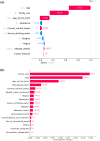The application of machine learning approaches to classify and predict fertility rate in Ethiopia
- PMID: 39833250
- PMCID: PMC11756417
- DOI: 10.1038/s41598-025-85695-8
The application of machine learning approaches to classify and predict fertility rate in Ethiopia
Abstract
Integrating machine learning (ML) models into healthcare systems is a rapidly evolving field with the potential to revolutionize care delivery. This study aimed to classify fertility rates and identify significant predictors using ML models among reproductive women in Ethiopia. This study utilized eight ML models in 5864 reproductive-age women using Ethiopian Demographic Health Survey (EDHS), 2019 data. Phyton programming language was used to develop these models. Predictors of fertility rate were determined using the feature important techniques. The performance of models was evaluated using accuracy, area under the curve (AUC), precision, recall, F1-score, specificity, and sensitivity. The mean age of participants was 32.7 (± 5.6) years. The random forest classifier (accuracy = 0.901 and AUC = 0.961) followed by a one-dimensional convolutional neural network (accuracy = 0.899 and AUC = 0.958), logistic regression (accuracy = 0.874 and AUC = 0.937), and gradient boost classifier (accuracy = 0.851 and AUC 0.927) were the top performing ML models. Family size, age, occupation, and education with an average importance score of 0.198, 0.151, 0.118, and 0.081, respectively were the top significant predictors of the fertility rate. The best ML models to classify and predict fertility rates were random forest, one-dimensional convolutional neural network, logistic regression, and gradient boost classifier. The findings on important factors of fertility rate can inform targeted public health, programs that address disparities related to family size, occupation, education, and other socioeconomic factors.
Keywords: Classification; EDHS data; Ethiopia; Fertility rate; Machine learning; Prediction.
© 2025. The Author(s).
Conflict of interest statement
Declarations. Competing interests: The authors declare no competing interests. Ethics approval and consent to participate: This study is a secondary data analysis from the EDHS data, so it does not require ethical approval. For conducting this study, online registration and request for measure DHS were conducted. The dataset was downloaded from the DHS online archive from the MEASURE DHS dataset for free after getting approval to access the data. Patient and public involvement: The study was conducted using secondary data and did not involve patient or public participation.
Figures





Similar articles
-
Application of machine learning algorithm for prediction of abortion among reproductive age women in Ethiopia.Sci Rep. 2025 May 23;15(1):17924. doi: 10.1038/s41598-025-95342-x. Sci Rep. 2025. PMID: 40410396 Free PMC article.
-
Machine learning algorithms to predict khat chewing practice and its predictors among men aged 15 to 59 in Ethiopia: further analysis of the 2011 and 2016 Ethiopian Demographic and Health Survey.Front Public Health. 2025 Mar 27;13:1555697. doi: 10.3389/fpubh.2025.1555697. eCollection 2025. Front Public Health. 2025. PMID: 40213427 Free PMC article.
-
Machine learning applications to classify and monitor medication adherence in patients with type 2 diabetes in Ethiopia.Front Endocrinol (Lausanne). 2025 Mar 20;16:1486350. doi: 10.3389/fendo.2025.1486350. eCollection 2025. Front Endocrinol (Lausanne). 2025. PMID: 40182636 Free PMC article.
-
Machine learning algorithms for prediction of measles one vaccination dropout among 12-23 months children in Ethiopia.BMJ Open. 2024 Nov 14;14(11):e089764. doi: 10.1136/bmjopen-2024-089764. BMJ Open. 2024. PMID: 39542486 Free PMC article.
-
Predicting determinants of unimproved water supply in Ethiopia using machine learning analysis of EDHS-2019 data.Sci Rep. 2025 Apr 4;15(1):11561. doi: 10.1038/s41598-025-96412-w. Sci Rep. 2025. PMID: 40185896 Free PMC article.
Cited by
-
Forecasting birth trends in Ethiopia using time-series and machine-learning models: a secondary data analysis of EDHS surveys (2000-2019).BMJ Open. 2025 Jul 16;15(7):e101006. doi: 10.1136/bmjopen-2025-101006. BMJ Open. 2025. PMID: 40669913 Free PMC article.
-
Application of machine learning algorithms and SHAP explanations to predict fertility preference among reproductive women in Somalia.Sci Rep. 2025 Jul 20;15(1):26301. doi: 10.1038/s41598-025-04704-y. Sci Rep. 2025. PMID: 40685342 Free PMC article.
References
-
- World Health Organization The Global Health Observatory. Total fertility rate (per woman). https://www.who.int/data/gho/indicator-metadata-registry/imr-details/123. Accessed 04 Sep 2024.
-
- United Nations and Population. https://www.un.org/en/global-issues/population. Accessed 10 June 2024.
-
- UN, United Nations, Department of Economic and Social Affairs PD. World Population Prospects: The 2019 Revision | Multimedia Library—United Nations Department of Economic and Social Affairs, Vol. 9, 1–13. https://population.un.org/wpp/Download/Standard/Population (2019).
MeSH terms
LinkOut - more resources
Full Text Sources

